

Mars Polar Lander
Entry, Descent and LandingDecember 3, 1999
20:00:26 UTC (12:00:26 PM PST)Pre-Entry Events
Entry, Desent And Landing
Selecting A Landing Site
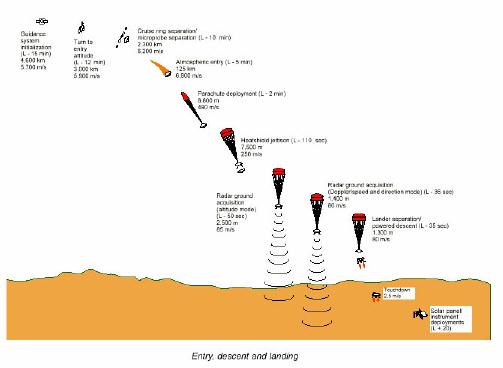
Entry, Descent And Landing Of The Mars Polar Lander

Pre-Entry Events
Preparations for the lander's entry into the Martian atmosphere will begin 14 hours in advance, when the final four-hour tracking session of the cruise period begins. This will be the final opportunity for ground controllers to gather navigation data before entry. About 12 hours before entry, software which normally puts the spacecraft in safe mode in reaction to unexpected events will be disabled for the remainder of the spacecraft's flight and descent to the surface.
At seven hours and 25 minutes before entry, a 30-minute tracking session will begin. If a final trajectory correction maneuver is required to fine-tune the spacecraft's flight path, computer commands for that thruster firing could be sent to the spacecraft during this session. The maneuver would be executed as late as seven hours before entry.
A one-hour tracking session will begin five hours before entry. This session will be used to monitor spacecraft health and status and perform tracking after the final thruster firing. During this tracking session, at four hours and 40 minutes before entry, a series of valves will open to vent the descent engines. A pyro valve will fire at four hours and 30 minutes before entry to pressurize the descent engines.

Final contact with the spacecraft will begin 25 minutes before entry and will last 15 minutes. During this tracking session, the spacecraft team will receive information on the status of the propulsion system. Starting about 20 minutes before entry, heaters on the lander's thrusters will be turned on. Fifteen minutes before entry, software controlling the Mars Descent Imager will be initialized.
About 10 minutes before entry, the spacecraft will be commanded to switch to inertial navigation - computing its position, course and speed from gyroscopes and accelerometers. Six minutes before entry, the spacecraft will fire its thrusters for 80 seconds to turn it to its entry orientation. Five minutes before entry and 10 minutes before landing, the cruise stage will separate from the aeroshell-encased lander. Cut off from the cruise stage's solar panels, the lander will rely on its internal battery until it can unfold its own solar panels on the planet's surface. The Deep Space 2 microprobes, piggybacking on the lander's cruise stage, will be jettisoned about 18 seconds later. The lander will then be commanded to assume the correct orientation for atmospheric entry.

Traveling at about 6.8 kilometers per second (15,400 miles per hour), the spacecraft will enter the upper fringe of Mars' atmosphere some 33 to 37 seconds later. Onboard accelerometers, sensitive enough to detect "G" forces as little as 3/100ths of Earth's gravity, will sense when friction from the atmosphere causes the lander to slow slightly. At this point, the lander will begin using its thrusters to keep the entry capsule aligned with its direction of travel. Entry, Descent and Landing
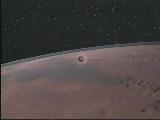

The spacecraft's descent from the time it hits the upper atmosphere until it lands takes no more than 4 minutes and 33 seconds to accomplish. As it descends, the spacecraft will experience G forces up to 12 times Earth's gravity, while the temperature of its heat shield rises to 1650 °C (3000 °F).


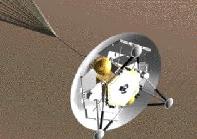
About two minutes before landing, the lander's parachute will be fired from a mortar (or small cannon) when the spacecraft is moving at about 493 meters per second (1,100 miles per hour) some 7.3 kilometers (4.5 miles) above the Martian surface. Ten seconds after the parachute opens, the Mars Descent Imager will be powered on and the spacecraft's heat shield will be jettisoned. The first descent image will be taken 0.3 seconds before heat-shield separation. The imager will take a total of about 10 pictures during the spacecraft's descent to the surface.
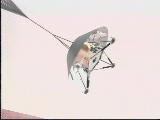

About 70 to 100 seconds before landing, the lander legs will be deployed; 1.5 seconds after that, the landing radar will be activated. The radar will be able to gauge the spacecraft's altitude about 44 seconds after it is turned on, at an altitude of about 2.5 kilometers (1.5 miles) above the surface.

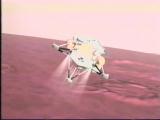

Shortly after radar ground acquisition, when the spacecraft is traveling at about 80 meters per second (180 miles per hour) some 1.4 kilometers (4,600 feet) above the surface, the thrusters that the spacecraft has used for maneuvers throughout its cruise will be turned off, and the backshell will separate from the lander. The descent engines will be turned on one-half second later, turning the lander so its flight path gradually becomes vertical.



The pulse-modulated descent engines will maintain the spacecraft's orientation as it descends. The engines will fire to roll the lander to its proper orientation so that it lands with the solar panels in the best orientation to generate power as the Sun moves across the sky. The radar will be turned off at an altitude of about 40 meters (130 feet) above the surface, and the spacecraft will fall back on its gyros and accelerometers for inertial guidance as it lands.

Once the spacecraft reaches either an altitude of 12 meters (40 feet) or a velocity of 2.4 meters per second (5.4 miles per hour), the lander will drop straight down at a constant speed. The descent engines will be turned off when touchdown is detected by sensors in the footpads. The engines will have been on for a total of about 40 seconds during final descent to the surface.
Selecting A Landing Site
Mars Global Surveyor TES Measurements Of The Landing Site

Mars Polar Lander Target Landing
Landed Operations Phase
| Home | Mars Polar Lander | Deep Space 2 Microprobes | Mars Climate Orbiter |
| Welcome | Mailing List | Links | Credits |
For questions or comments on this website please refer to our list of contacts.